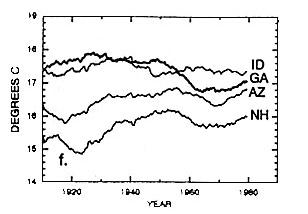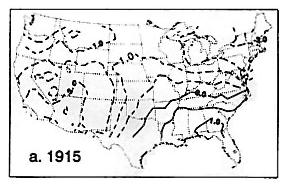 |
|||||||||
|
|
|||||||||
|
|
|||||||||
 |
|||||||||
|
|
|||||||||
|
|
|||||||||

Physical processes -- by themselves and through interaction with fluid-dynamical ones -- are important factors in the maintenace and variability of the observed state of the climate system. The TCD group engages in modeling various aspects of these processes, through the study of: energy balance models, ice-sheet models, and coupling of slow physical processes on the paleoclimate time scale, hydrological cycle,
interaction between thermal and dynamical processes,
planetary boundary layer, radiative-convective equilibria
.
As we attempt to penetrate further into the remote past, evidence for climate change becomes sketchier, in both temporal and spatial detail. To help understand this limited information on dramatic alternations between a relatively ice-covered and ice-free planet, simple models can capture the major feedbacks between the atmosphere, ice sheets, oceans and biota. The figure shows both a perspective from space of such a model's surface features (left) and its vertical cross-section (right; from Ghil, 1994). The model solution's power spectrum is compared with that of an isotopic proxy record for air temperature from the Vostok ice core (from Yiou et al., 1994).
Radiative-convective model
 Radiative-convective (RCM: vertical variation, horizontally averaged) and energy-balance (EBM: horizontal variation; vertically integrated) models are the two simplest types of models which capture the basic physical processes in the atmosphere. These models can reveal the underlying processes and mechanisms, as well as help improve more comprehensive models. Using the two-stream approximation for radiative transfer in a simple column model with temperature-dependent surface albedo, an RCM provides a tool to study: 1) radiative multiple equilibria and their stability, and 2) their sensitivity to changes in the atmosphere's optical properties. The figure shows multiple equilibria of the model's temperature profile:
a) present (surface albedo=0.3; stable),
b) totally ice-coverd (albedo=0.9; stable), and
c) intermediate (albedo=0.525; unstable) climate
along with the general circulation model's (GCM's)
horizontally averaged temperatude profile (from Li et al. 1997).
Radiative-convective (RCM: vertical variation, horizontally averaged) and energy-balance (EBM: horizontal variation; vertically integrated) models are the two simplest types of models which capture the basic physical processes in the atmosphere. These models can reveal the underlying processes and mechanisms, as well as help improve more comprehensive models. Using the two-stream approximation for radiative transfer in a simple column model with temperature-dependent surface albedo, an RCM provides a tool to study: 1) radiative multiple equilibria and their stability, and 2) their sensitivity to changes in the atmosphere's optical properties. The figure shows multiple equilibria of the model's temperature profile:
a) present (surface albedo=0.3; stable),
b) totally ice-coverd (albedo=0.9; stable), and
c) intermediate (albedo=0.525; unstable) climate
along with the general circulation model's (GCM's)
horizontally averaged temperatude profile (from Li et al. 1997).
Variability in United States surface-air temperatures
 Changes in surface-air temperature are one of most "obvious" indications of climate change. Continental- or regional-scale temperature variations may be related to climatic variations with similar periodicities, either global or centered in other regions.
The upper figure shows the time series of average temperatures over traditional climate divisions from Georgia (GA), Arizona (AZ), Idaho (ID) plus 10C, and New Hampshire (NH) plus 10C. The lower figure shows the contour plots of temperature-index reconstructions in 1915 and 1975, dashed where negative; contour interval is 0.05 standard deviations (of overall variability) times 10 (from Dettinger et al. 1995). The point is that there is substantial spatial variability in climate trends: even over a relatively small fraction of the globe, like the contiguous United States, interdecadal temperature changes can proceed in different directions at different times and in different subregions.
Changes in surface-air temperature are one of most "obvious" indications of climate change. Continental- or regional-scale temperature variations may be related to climatic variations with similar periodicities, either global or centered in other regions.
The upper figure shows the time series of average temperatures over traditional climate divisions from Georgia (GA), Arizona (AZ), Idaho (ID) plus 10C, and New Hampshire (NH) plus 10C. The lower figure shows the contour plots of temperature-index reconstructions in 1915 and 1975, dashed where negative; contour interval is 0.05 standard deviations (of overall variability) times 10 (from Dettinger et al. 1995). The point is that there is substantial spatial variability in climate trends: even over a relatively small fraction of the globe, like the contiguous United States, interdecadal temperature changes can proceed in different directions at different times and in different subregions.


Quaternary glaciation cycles
| TCD Members: | |||||||||||||||||||||||||||||||||||||||||
| M. Dettinger, M. Ghil, M. Huber, K. Ide, P. Yiou, F. Varadi | |||||||||||||||||||||||||||||||||||||||||
| References:
|
Birchfield, G. E., and M. Ghil, 1993: Climate evolution in the
Pliocene and Pleistocene from marine-sediment records and simulations: Internal variability versus orbital forcing, J. Geophys. Res., 98D, 10385-10399.
|
Climate Research Committee (E. J. Barron, B. Boville, K. Bryan, G. F.
Carrier, W. L. Chameides, R. Dickinson, M. Ghil, D. G. Martinson, W. R.
Peltier, J. Sarmiento, G. L. Stephens, L. D. Talley, K. Trenberth and J.
Walsh), 1992: A Decade of International Climate Research: The First Ten Years of the World Climate Research Program, National Academy Press, Washington, D.C., 59 pp.
|
Dettinger, M. D., M. Ghil and C. L. Keppenne, 1995: Interannual and
interdecadal variability in United States surface-air temperatures,
1910-87, Climatic Change, 31, 35-66.
|
Ghil, M., l976: Climate stability for a Sellers-type model, J. Atmos. Sci., 33, 3-20.
|
Ghil, M., 1989: Deceptively-simple models of climatic change, Climate and Geo-Sciences, A. Berger, J.-Cl. Duplessy and S. H. Schneider (Eds.), D. Reidel, Dordrecht/Hingham (Mass.), pp. 211-240.
| Ghil, M., 1991: Quaternary glaciations: Theory and observations, The Sun in Time, C. P. Sonnett, M. S. Giampapa, and M. S. Matthews (Eds.), The Univ. of Arizona Press, Tucson, pp. 511-542.
|
Ghil, M., 1994: Cryothermodynamics: The chaotic dynamics of paleoclimate, Physica D, 77, 130-159.
| Ghil, M., 1996: Atmospheric modeling, Natural Climate Variability on Decade-to-Century Time-Scales, D. G. Martinson et al. (Eds.), pp. 164-168.
|
Ghil, M. and H. Le Treut, l98l: A climate model with cryodynamics and geodynamics, J. Geophys. Res., 86, 5262-5270.
|
Ghil, M., R. Benzi and G. Parisi (Eds.), l985: Turbulence and Predictability in Geophysical Fluid Dynamics and Climate Dynamics, North-Holland Publ. Co., Amsterdam/New York/Oxford/ Tokyo, 449 pp.
| Ghil, M., and S. Childress, 1987: Topics in Geophysical Fluid Dynamics: Atmospheric Dynamics, Dynamo Theory and Climate Dynamics, Springer-Verlag, New York/Berlin/London/Paris/ Tokyo, 485 pp. (Ch. 10)
|
Ghil, M., A. Mullhaupt and P. Pestiaux, 1987: Deep water formation and quaternary glaciations, Climate Dyn., 2, 1-10.
|
Le Treut, H., and M. Ghil, l983: Orbital forcing, climatic interactions, and glaciation cycles, J. Geophys. Res., 88C, 5l67-5l90.
|
Li, Z.-X., K. Ide, H. LeTreut, and M. Ghil, 1997:
Atmospheric radiative equilibria in a simple column model.
Clim. Dyn., 13, 429-440.
|
National Research Council, 1995:
Natural Climate Variability on Decade-to-Century Time Scales,
D. G. Martinson, K. Bryan, M. Ghil, M. M. Hall, T. R. Karl, E. S. Sarachik, S. Sorooshian, and L. D. Talley (Eds.), National Academy Press, Washington, D.C., 630 pp.
|
Paillard, D., M. Ghil and H. Le Treut, 1993: Dissolved organic matter
and the glacial-interglacial pCO2 problem, Global Biogeochem.
Cycles, 7, 901-914.
|
Plaut, G., M. Ghil and R. Vautard, 1995: Interannual and interdecadal
variability in 335 years of Central England temperatures, Science,
268, 710-713.
|
Vautard, R., and M. Ghil, 1989: Singular spectrum analysis in nonlinear dynamics, with applications to paleoclimatic time series, Physica D, 35, 395-424.
|
Yiou, P., M. Ghil, J. Jouzel, D. Paillard and R. Vautard, 1994:
Nonlinear variability of the climatic system, from singular and power
spectra of late Quaternary records, Climate Dyn., 9,
371-389.
| | |||||||||||||||||||||